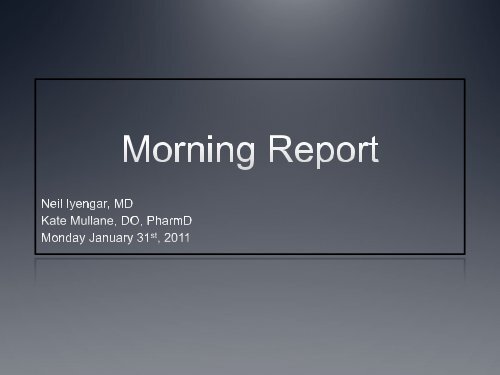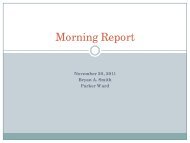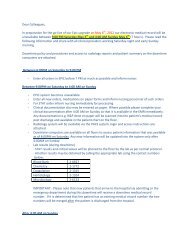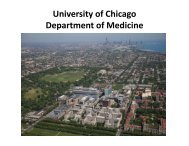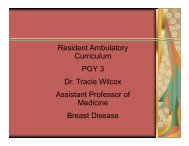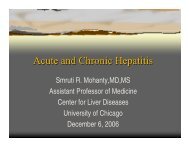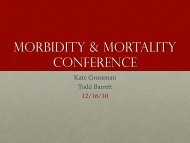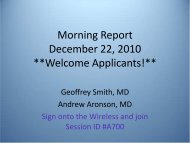Pott's disease in pregnancy - The University of Chicago Department ...
Pott's disease in pregnancy - The University of Chicago Department ...
Pott's disease in pregnancy - The University of Chicago Department ...
You also want an ePaper? Increase the reach of your titles
YUMPU automatically turns print PDFs into web optimized ePapers that Google loves.
MKSAP<br />
An 18-year-old woman is evaluated <strong>in</strong> the emergency department<br />
because <strong>of</strong> a 3-day history <strong>of</strong> lower abdom<strong>in</strong>al pa<strong>in</strong>. She does not<br />
have ur<strong>in</strong>ary frequency, dysuria, flank pa<strong>in</strong>, nausea, or vomit<strong>in</strong>g.<br />
Her only medication is an oral contraceptive agent.<br />
On physical exam<strong>in</strong>ation, temperature is 38.3 °C (101.0 °F), blood<br />
pressure is 118/68 mm Hg, pulse rate is 104/m<strong>in</strong>, and respiration<br />
rate is 16/m<strong>in</strong>. Abdom<strong>in</strong>al exam<strong>in</strong>ation is normal. <strong>The</strong>re is no flank<br />
tenderness. Pelvic exam<strong>in</strong>ation shows cervical motion tenderness,<br />
fundal tenderness, and bilateral adnexal tenderness on bimanual<br />
exam<strong>in</strong>ation.<br />
<strong>The</strong> leukocyte count and ur<strong>in</strong>alysis are normal. Ur<strong>in</strong>e and serum<br />
<strong>pregnancy</strong> tests are negative.
Which <strong>of</strong> the follow<strong>in</strong>g is the most appropriate treatment?<br />
A. Ampicill<strong>in</strong> and gentamic<strong>in</strong>, <strong>in</strong>travenously<br />
B. Azithromyc<strong>in</strong>, orally<br />
C. Cefoxit<strong>in</strong>, <strong>in</strong>tramuscularly<br />
D. Ceftriaxone, <strong>in</strong>tramuscularly, and doxycycl<strong>in</strong>e, orally<br />
E. Metronidazole, orally
Which <strong>of</strong> the follow<strong>in</strong>g is the most appropriate<br />
treatment?<br />
A. Ampicill<strong>in</strong> and gentamic<strong>in</strong>,<br />
<strong>in</strong>travenously<br />
B. Azithromyc<strong>in</strong>, orally<br />
C. Cefoxit<strong>in</strong>, <strong>in</strong>tramuscularly<br />
D. Ceftriaxone IM &<br />
doxycycl<strong>in</strong>e PO<br />
E. Metronidazole, orally<br />
20% 20% 20% 20% 20%<br />
A. B. C. D. E.
This patient’s cl<strong>in</strong>ical f<strong>in</strong>d<strong>in</strong>gs are compatible with pelvic <strong>in</strong>flammatory <strong>disease</strong> (PID), and<br />
she should receive <strong>in</strong>tramuscularly delivered ceftriaxone and oral doxycycl<strong>in</strong>e.<br />
PID is a polymicrobial <strong>in</strong>fection <strong>of</strong> the endometrium, fallopian tubes, and ovaries;<br />
diagnosis is based on the presence <strong>of</strong> abdom<strong>in</strong>al discomfort, uter<strong>in</strong>e or adnexal<br />
tenderness, or cervical motion tenderness.<br />
Other diagnostic criteria <strong>in</strong>clude temperature higher than 38.3 °C (101.0 °F), cervical or<br />
vag<strong>in</strong>al mucopurulent discharge, leukocytes <strong>in</strong> vag<strong>in</strong>al secretions, and documentation <strong>of</strong><br />
gonorrheal or chlamydial <strong>in</strong>fection.<br />
PID is most likely to occur with<strong>in</strong> 7 days <strong>of</strong> the onset <strong>of</strong> menses. All women with<br />
suspected PID should be tested for <strong>in</strong>fection with gonorrhea and chlamydia and undergo<br />
<strong>pregnancy</strong> test<strong>in</strong>g. In severe cases, imag<strong>in</strong>g should be performed to exclude a tuboovarian<br />
abscess. Ambulatory patients are treated with ceftriaxone and doxycycl<strong>in</strong>e with<br />
or without metronidazole.<br />
Duration <strong>of</strong> treatment is 14 days. Patients with PID should be hospitalized if there is (1)<br />
no cl<strong>in</strong>ical improvement after 48 to 72 hours <strong>of</strong> antibiotics; (2) an <strong>in</strong>ability to tolerate oral<br />
antibiotics; (3) severe illness with nausea, vomit<strong>in</strong>g, or high fever; (4) suspected <strong>in</strong>traabdom<strong>in</strong>al<br />
abscess; (4) <strong>pregnancy</strong>; or (5) noncompliance with outpatient therapy.
27 F G4P2 @ 12 weeks p/w chest/back pa<strong>in</strong>
27 F G4P2 @ 12 weeks p/w chest/back pa<strong>in</strong><br />
3 week h/o worsen<strong>in</strong>g mid-thoracic pa<strong>in</strong><br />
Seen 1 week ago at OSH ER and DC’d with Tylenol<br />
30 lb weight loss s<strong>in</strong>ce start <strong>of</strong> <strong>pregnancy</strong><br />
Mild SOB with pa<strong>in</strong>
27 F G4P2 @ 12 weeks p/w chest/back pa<strong>in</strong><br />
PMH<br />
Stillbirth @ 32 weeks<br />
PSH<br />
None<br />
Social<br />
1 ppd x 10 years (now 1 cig<br />
per day dur<strong>in</strong>g <strong>pregnancy</strong>)<br />
Occasional marijuana use<br />
No EtOH or IVDA<br />
Unemployed<br />
Family<br />
Mother – HTN, DM<br />
Father – HTN, DM<br />
Meds<br />
Prenatal vitam<strong>in</strong>s<br />
Tylenol prn
Differential Diagnosis?
Physical Exam<br />
VS T 35.8 HR 96 BP 122/81 RR 20 98% RA<br />
Gen: Gravid AAF <strong>in</strong> NAD<br />
HEENT: PERRLA, EOMI, anicteric, o/p clear<br />
Neck: No LAD<br />
CV: RRR, s1/s2, no m/r/g, no JVD<br />
Lungs: CTAB<br />
Abd: Gravid uterus, size c/w date, NT, +bowel sounds<br />
Msk: TTP @ mid thoracic sp<strong>in</strong>e, mild b/l calf TTP<br />
Neuro: A&Ox3, 3/5 L hand grip strength otherwise 5/5 throughout.<br />
CN II-XII <strong>in</strong>tact.<br />
Derm: No rashes
Bratton RL. Am Fam Physician 1999.<br />
Back Pa<strong>in</strong> Differential
Bratton RL. Am Fam Physician 1999.<br />
Sp<strong>in</strong>al Nerve Roots
Labs/Studies?
10.3<br />
6.4 662<br />
32.1<br />
N 60% L 25% M 14% E 0%<br />
7.9 3.3<br />
0.3 0.1/0.2<br />
16 15<br />
199<br />
Studies<br />
CK 25<br />
CKMB 2.0<br />
Trop T 120<br />
UA<br />
pH 8.0<br />
LE neg<br />
Nitrites neg<br />
Prote<strong>in</strong> neg<br />
Blood trace<br />
WBC 5-10
EKG: NSR, no ischemic changes<br />
BLE Dopplers: No DVT<br />
Studies
Radiation dur<strong>in</strong>g Pregnancy<br />
Toppenberg KS, Hill A, Miller DP. Am Fam Physician 1999.
Toppenberg KS, Hill A, Miller DP. Am Fam Physician 1999.<br />
Radiation dur<strong>in</strong>g Pregnancy
CT Chest<br />
Studies
Studies<br />
CT Chest:<br />
Impression:<br />
1. No evidence <strong>of</strong> acute PE.<br />
2. Destructive s<strong>of</strong>t tissue mass <strong>in</strong>volv<strong>in</strong>g the lower cervical and<br />
upper thoracic sp<strong>in</strong>e with pathologic fracture <strong>of</strong> T3. <strong>The</strong> mass<br />
displaces the trachea and esophagus anteriorly and encroaches<br />
upon the areas <strong>of</strong> exit<strong>in</strong>g nerve roots <strong>of</strong> the upper thoracic sp<strong>in</strong>e.<br />
3. Multiple calcified mediast<strong>in</strong>al and hilar lymph nodes are also<br />
noted.
Abscess<br />
Pyogenic osteomyelitis<br />
Differential <strong>of</strong> vertebral lesion<br />
S. aureus, brucellosis, melioidosis<br />
Invasive fungal <strong>disease</strong><br />
Histoplasmosis, act<strong>in</strong>omycosis, candidiasis<br />
Atypical <strong>in</strong>fection<br />
Mycobacterium<br />
Lymphoma<br />
Multiple myeloma<br />
Metastatic lesion<br />
Trophoblastic <strong>disease</strong>
ESR 126<br />
CRP 113<br />
Blood Cx: Neg<br />
HIV: Nonreactive<br />
Histo: Neg<br />
Blasto: Neg<br />
Hep B S Ag: Neg<br />
HCV Ab: Neg<br />
Additional Studies<br />
PPD Refused: Additional history- pt had PPD placed 1 month ago at<br />
OSH and developed pa<strong>in</strong>ful swell<strong>in</strong>g at site.
1. Extensive marrow signal replacement <strong>of</strong> vertebral bodies <strong>of</strong> C5 – T5 with<br />
large perisp<strong>in</strong>al s<strong>of</strong>t tissue mass.<br />
2. Compression fracture <strong>of</strong> T3.<br />
3. Significant extension <strong>of</strong> s<strong>of</strong>t tissues <strong>in</strong>to the ventral epidural space with tight<br />
sp<strong>in</strong>al stenosis at T3.<br />
4. Normal signal <strong>in</strong>tensity <strong>of</strong> the cord.<br />
5. Significant bulge <strong>of</strong> the disk material and hypertrophied changes along the<br />
ventral aspect <strong>of</strong> the canal at C5 and C6 with central sp<strong>in</strong>al stenosis.
Additional Studies<br />
CT-guided needle biopsy: Successful aspiration <strong>of</strong> 5 cc <strong>of</strong> green<br />
purulent fluid from parasp<strong>in</strong>al fluid collection.<br />
Smear: 3+ AFB
Incidence per<br />
100,000<br />
90<br />
80<br />
70<br />
60<br />
50<br />
40<br />
30<br />
20<br />
10<br />
0<br />
Sp<strong>in</strong>al TB<br />
1950 1960 1970 1980 1990 2000 2010<br />
Percivall Pott 1776<br />
• Incidence <strong>of</strong> TB <strong>in</strong> the US has<br />
decl<strong>in</strong>ed for most <strong>of</strong> the 20th Century<br />
• 20% have extrapulmonary TB<br />
• Of these, 10% have skeletal<br />
<strong>in</strong>volvement<br />
• Initial radiographs are <strong>of</strong>ten unreveal<strong>in</strong>g<br />
• May spare the disc space entirely while caus<strong>in</strong>g central rarefaction <strong>of</strong> the<br />
vertebral body3 • MRI is diagnostic study <strong>of</strong> choice<br />
• Abscess formation <strong>in</strong> the anterior s<strong>of</strong>t tissues and collection <strong>of</strong><br />
granulation tissue adjacent to vertebral body<br />
McLa<strong>in</strong> RF, Isada C. Cleveland Cl<strong>in</strong>ic Journal <strong>of</strong> Medic<strong>in</strong>e 2004; 71(7): 537-549.
Pott’s Disease<br />
McLa<strong>in</strong> RF, Isada C. Cleveland Cl<strong>in</strong>ic Journal <strong>of</strong> Medic<strong>in</strong>e 2004; 71(7): 537-549.
Complications<br />
Pregnancy m<strong>in</strong>imally impacts <strong>disease</strong> progression but <strong>of</strong>ten obscures<br />
<strong>in</strong>itial diagnosis lead<strong>in</strong>g to greater risk <strong>of</strong> complications 1<br />
Psoas abscess<br />
Cauda equ<strong>in</strong>a compression result<strong>in</strong>g <strong>in</strong> paraplegia or quadriplegia<br />
Men<strong>in</strong>gitis<br />
Premature labor result<strong>in</strong>g <strong>in</strong> stillbirth<br />
Autonomic dysreflexia caus<strong>in</strong>g dysregulation <strong>of</strong> sympathetic sp<strong>in</strong>al<br />
reflexes and severe hypertension when lesion is above T62, 5<br />
Rarely <strong>in</strong>fects the fetus, but has been reported to spread<br />
lymphohematogenously via the <strong>in</strong>fected placenta at time <strong>of</strong> delivery 1<br />
1. Hamadeh MA, Glassroth J. Chest 1992; 101: 1114-1120.<br />
2. Luewan S, Bunmaprasert T, Chiengthong K, Tongsong T. Int J Gynaecol Obstet 2008; 102(3): 298-300.<br />
3. Rosenfeld JV, Torey EI, Michael MS, Johnson MM. J Cl<strong>in</strong> Neuroscience 1998; 5(2): 212-215.
Myers TH. J Bone Jo<strong>in</strong>t Surg Am 1891; s1-4: 124-131.<br />
Treatment
Treatment<br />
Pregnant women diagnosed with TB should be treated without delay1, 3, 5<br />
Drug therapy is cornerstone <strong>of</strong> successful management<br />
Unlike the management <strong>of</strong> many <strong>in</strong>fected fluid collections, dra<strong>in</strong>age and<br />
surgery <strong>in</strong> Pott’s <strong>disease</strong> are adjunctive, rather than primary,<br />
<strong>in</strong>terventions<br />
Adjunctive post-parturition surgery – abscess dra<strong>in</strong>age, debridement <strong>of</strong><br />
necrotic bone and disc, and reconstruction <strong>of</strong> local sp<strong>in</strong>al column<br />
Agent Pregnancy<br />
Category<br />
Isoniazid C<br />
Rifamp<strong>in</strong> C<br />
Pyraz<strong>in</strong>amide C<br />
Ethambutol B<br />
Streptomyc<strong>in</strong> D<br />
1. Hamadeh MA, Glassroth J. Chest 1992; 101: 1114-1120.<br />
2. McLa<strong>in</strong> RF, Isada C. Cleveland Cl<strong>in</strong>ic Journal <strong>of</strong> Medic<strong>in</strong>e 2004; 71(7): 537-549.<br />
3. Rosenfeld JV, Torey EI, Michael MS, Johnson MM. J Cl<strong>in</strong> Neuroscience 1998; 5(2): 212-215.
Case Conclusion<br />
4-drug therapy with INH, pyraz<strong>in</strong>amide, ethambutol, rifamp<strong>in</strong>, and<br />
vitam<strong>in</strong> B6 <strong>in</strong>itiated<br />
Uncomplicated NSVD at 36 weeks<br />
Completed 9 month course<br />
No surgical <strong>in</strong>tervention required
References<br />
1. Hamadeh MA, Glassroth J. Tuberculosis and Pregnancy. Chest 1992; 101: 1114-1120.<br />
2. Luewan S, Bunmaprasert T, Chiengthong K, Tongsong T. Sp<strong>in</strong>al Tuberculosis <strong>in</strong> Pregnancy. Int J<br />
Gynaecol Obstet 2008; 102(3): 298-300.<br />
3. McLa<strong>in</strong> RF, Isada C. Sp<strong>in</strong>al Tuberculosis Deserves a Place on the Radar Screen. Cleveland<br />
Cl<strong>in</strong>ic Journal <strong>of</strong> Medic<strong>in</strong>e 2004; 71(7): 537-549.<br />
4. Myers TH. Pott’s Disease and Pregnancy. J Bone Jo<strong>in</strong>t Surg Am 1891; s1-4: 124-131.<br />
5. Rosenfeld JV, Torey EI, Michael MS, Johnson MM. Tuberculous Sp<strong>in</strong>al Cord Compression <strong>in</strong><br />
Pregnancy. J Cl<strong>in</strong> Neuroscience 1998; 5(2): 212-215.<br />
6. Toppenberg KS, Hill A, Miller DP. Safety <strong>of</strong> Radiographic Imag<strong>in</strong>g Dur<strong>in</strong>g Pregnancy. Am Fam<br />
Physician 1999.<br />
7. Arce D, Sass P, Abdul-Khoudoud H. Recogniz<strong>in</strong>g Sp<strong>in</strong>al Cord Emergencies. Am Fam Physician<br />
2001; 64(4):631-639.<br />
8. Bratton RL. Assessment and Management <strong>of</strong> Acute Low Back Pa<strong>in</strong>. Am Fam Physician 1999.


